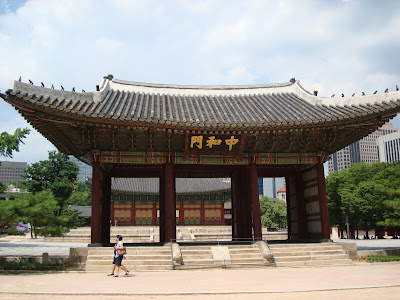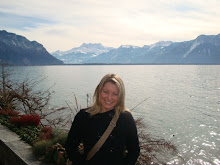My last day in Seoul was one of the days I had looked forward to the most because Nicholas had managed to sign me up for a tour of the DMZ, the De-Militarized Zone that separates South Korea from North Korea. It's the closest most people can get to North Korea, a country so known for its privacy and secrecy that even the best spying countries in the world don't know much about it. A quick check online reveals that Google Maps only shows the outline of the country's borders but no roads, landmarks, or cities.
I had to wake up at 6am in order to make it to the USO at Camp Kim by 7:45 where the tour started. The entrance to the camp was very subdued, with almost no signage at all marking it as US property. I was the first person to arrive, and joined the receptionist as he unlocked the doors. When I stepped inside I felt like Dorothy falling back into Kansas. The reception looked like a large Midwestern living room, with dark brown tile, two huge worn-out brown leather couches, an ancient Lazy Boy, and a huge flat screen television which was soon piping Olympic sports at full volume into the empty room.
After a few minutes other people began to arrive and eventually our bus showed up, with guests already on board. They did a roll call and I could see that the other people on the tour were Filipino, Singaporean, Russian, and American.
We headed off to drive north out of the city, with nothing unusual at all around us. But as we drove farther and got closer to the border the highway began to be lined with barbed wire and had loudspeakers and cameras mounted every 200m pointed towards the river. In accordance with that there were camoflaged guard posts stationed every 1500ft with soldiers with guns ready. As we got closer the guard stations became more frequent until they were every 300ft. At one point our guide showed us North Korea directly across the river from us.
We kept driving and arrived at "observation point". From this little viewing station you can look directly at North Korea, and they even provide helpful pay per use telescopes for your convenience. At first I scoffed it but then relented to pay the quite small 50c charge it wanted, and was glad I did. With the naked eye you could see buildings and factories and grass. The view with the binoculars gave much richer detail and besides the large white warehouses or factories lining the edge of the North Korean side, I could even see one man moving around attending to some crops (apparently).The lookout point was actually really cool. . The mountains sitting behind these buildings don't have any trees because the North Koreans cut them all down, supposedly to remove the possibility of hiding spots I suppose.
Next they took us to the 3rd Tunnel, one of the attack channels planned by North Korea during the height of tensions. There are 4 tunnels running from North Korea to South Korea which have been discovered so far over the last 40 years, and each one was clearly built by North Koreans. After discovery the North Koreans claimed they were for coal mining, however the rock inside is granite. Some experts estimate there could be a hundred of these tunnels running along the border. The one I visited was 5,100 feet long and 1,150 feet deep.
The other site we got to see was the "last train station in South Korea" which is literally, a train station, a few kilometers away from the border. It's more symbolic than anything, because the only people who get off at that stop are the handful of people who work at the DMZ and they all have to have gotten clearance before they can ride the train. The South, whether truthfully or just for show, is all about reunification. Everywhere the signs state how much they really want to be one country. North Korea, on the other hand, doesn't really seem to give a --.
After the tour dropped us back off in Seoul I took a quick swing through the Deoksu-gung Palace near City Hall. It was hot and humid, like every day, but the cicadas didn't mind at all and were chirping so loudly they actually hurt my ears when I walked too close to the trees. I was very strange to have a dusty ancient deserted palace hiding underneath skyscrapers in the middle of the city. After that I made a quick stop through Seoul Station for cash and a thank you gift for Nick and Nicki before heading back to their house around 16:00 to get my bags in time for my 19:40 flight. I figured I needed to be on a bus by 17:00 at the latest so I'd get to the airport by 18:00.
As I prepared to leave Seoul I reflected on what I had observed. 1 ) Being in a foreign country, especially one where you don't even understand the characters of the alphabet, makes you humble because it makes you a child again. You have to blindly follow what people tell you and trust in what they say and do because you don't have communication tools to explain yourself. One of my favorite stories was Nicki telling me that as soon as she learned to pronounce the Korean characters a whole new world opened up for her. The Koreans adopted many English words but converted them into Korean characters, so when she could understand it she suddenly discovered that her local lunch shop had "st-r-aw-ber-ry sm-oo-thie" clearly printed in large type on its menu.
2) You can tell a country's history from what you see around you. For example, by its electrical plugs. Seoul had European style plugs, perhaps from the Russian influence. By contrast, Singapore had UK plugs, reflecting its former rule by the British Empire. You can also tell the history from the abundance of or lack of western influence. Korea, for example, was completely westernized with Taco Bell, Smoothie King, Domino's, Papa John's, The Coffee Bean, Starbucks, Baskin Robbins, Dunkin Donuts, Bennigan's, Outback Steakhouse, and even a YMCA. This perhaps came about because of the American occupation following the Korean War?
3) The small but thoughtful things a city does to help its residents. Someone (either companies or the city) had been passing out thousands of paper fans for people to carry with them, and boy were the Korean using them. I was at least happy it was hot for them, too. The subway was well-organized and made an effort to provide an enjoyable experiecne. For example, the overhead speakers played a little musical jingle to announce an approaching train.
Welcome to Kansas.
Guards with guns making sure no one swims in.
Stay back and don't take pictures.
Promotion of reunification.
This is what I followed all day long.
You can't take pictures past the yellow line.
On the other side of this ledge is North Korea.
The last train station in the country has a gift shop, but no customers.
You can't get on a train here.
Geoksu gung Palace
In the middle of the city.
Beneath skyscrapers.















No comments:
Post a Comment